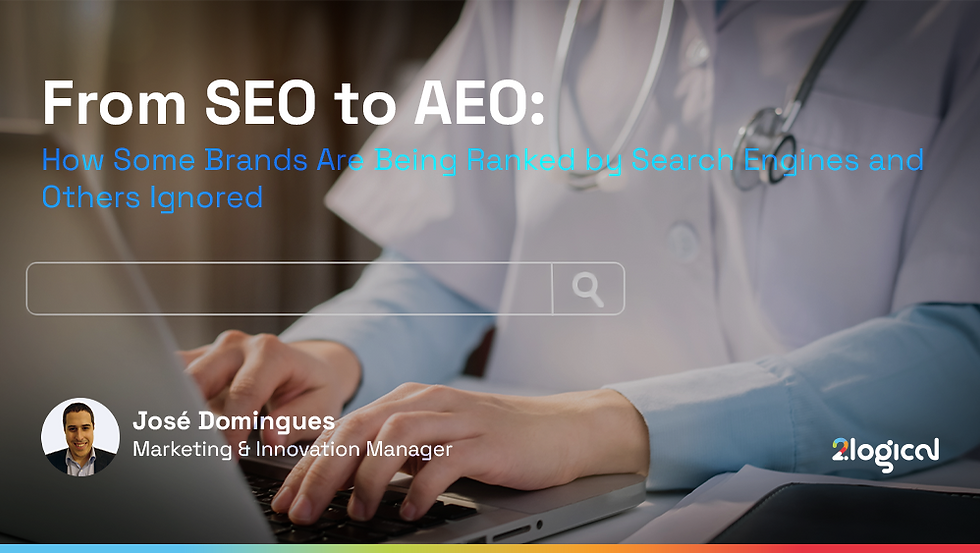From SEO to AEO: How Some Brands Are Being Ranked by Search Engines and Others Ignored
- José Domingues

- Jul 4
- 4 min read

Is your brand actually reaching its audience? Or are you being left out of the conversation? For years, mastering SEO (Search Engine Optimization) was essential. All that was needed was to optimize keywords, build backlinks and ensure that navigation on the site was quick and intuitive. Nowadays, it's not that simple.
With the rise of Artificial Intelligence and conversational search, we find ourselves in the age of AEO - Answer Engine Optimization. And to keep up with this change, it's essential to talk about Real-Time Digital Profiles.
What changed recently?
For the pharmaceutical and healthcare industry, this change is having a direct impact on the way companies relate with doctors, pharmacists and even patients themselves.
The search for clear and reliable answers (for example, about new treatments or OTC drugs) is now increasingly done using AI interfaces or voice searches. To be absent when these answers are given means losing visibility at critical decision-making moments.
Nowadays, users are no longer just looking for keywords. They are asking questions and expecting straightforward, quick and personalized answers, often through voice searches or AI interfaces (such as ChatGPT or Google's Gemini).
And the AI delivers. Instead of presenting a list of links, which is what search engines have done until now, they seek to give the best possible answer directly on the results page.
AEO (Answer Engine Optimization): what is it and why it matters?
AEO is the natural evolution of SEO: the focus is no longer on climbing the rankings, but rather on ensuring that the information presented is relevant, reliable and directly useful in answering users' questions.
And how is this achieved?
Creating clear, concise and factual content.
Directly answering the most common questions from the audience in question.
Using structured data (e.g. schema.org).
Schema.org is a markup language created by companies such as Google, Microsoft and Yahoo that allows you to add extra “context” to the content of a website. Instead of a simple paragraph of text, this markup helps search engines understand exactly what you're talking about.
Using natural, conversational language - like you're interacting in a conversation.
A practical illustration of this is, for example, when a pharmaceutical company releases data from a new study or prescription guidelines. A simple landing page is not enough. It is essential that the content is structured so that an AI can quickly extract and return the answer to the question: “Can this drug be used in patients with type 2 diabetes and kidney failure?”
The role of Real-Time Digital Profiles
To successfully achieve all of this, it's first important to know your target audience well and in real time. This is where Real-Time Digital Profiles are useful: dynamic, constantly updated representations that aggregate data from various sources (websites, social networks, CRM, apps, emailings, etc.).
For brands, these profiles enable them to:
Anticipate customer needs.
Personalize experiences and content.
Create accurate responses - something highly valued by algorithms when forming responses.
Make quick and more informed decisions.
Through 2Logical's HCP segmentation, profiling and digital scoring services, our clients are able to build these Profiles in Real Time based on real data. Channel preferences, interaction history, specialty and even prior campaign behavior are just a few examples of the capabilities at their disposal. This allows the responses generated by the AIs to be even more relevant and tailored to the caller.
But this doesn't mean the end of SEO. It's a transformation.
If you think SEO is going to disappear, think again. It's no longer enough on its own when it comes to getting visibility online. AEO complements it and expands the rationale behind SEO, adapting it to a reality where users want to see answers, not just links.
Classic SEO | Modern AEO | |
Goal | Be found on Google | Be the straightforward answer that AI provides |
Content | Focused on technical keywords | Focused on quick answers about therapeutic use, studies and guidelines |
Optimization | For search engines | For response engines, chatbots and voice |
Success Metrics | Organic traffic | AI response mentions, direct visibility |
And so, what now?
If you're looking to prepare your brand for this new reality, here are some practical tips:
Invest in content that answers questions
FAQs, quick guides, educational and “to the point” content.
Use structured data
Make life easier for algorithms by marking up your content with Schema.org.
Continuously monitor and update your users' data
Adjust your communication and anticipate your audience's needs more accurately.
Invest in AI and automation
For content analysis, personalization and delivery.
Focus on experience and conveying trust
Focus on experience and conveying trust
We are entering a new era of digital marketing - more conversational, more personalized and more immediate. Ignoring AEO and real-time digital profiles risks losing relevance in a world where being seen means being useful at the right time.

Today we are going through a new era of digital marketing - more conversational, personalized and immediate. At 2Logical we have been supporting companies in redefining their digital presence and creating content prepared for this new paradigm.



Comments